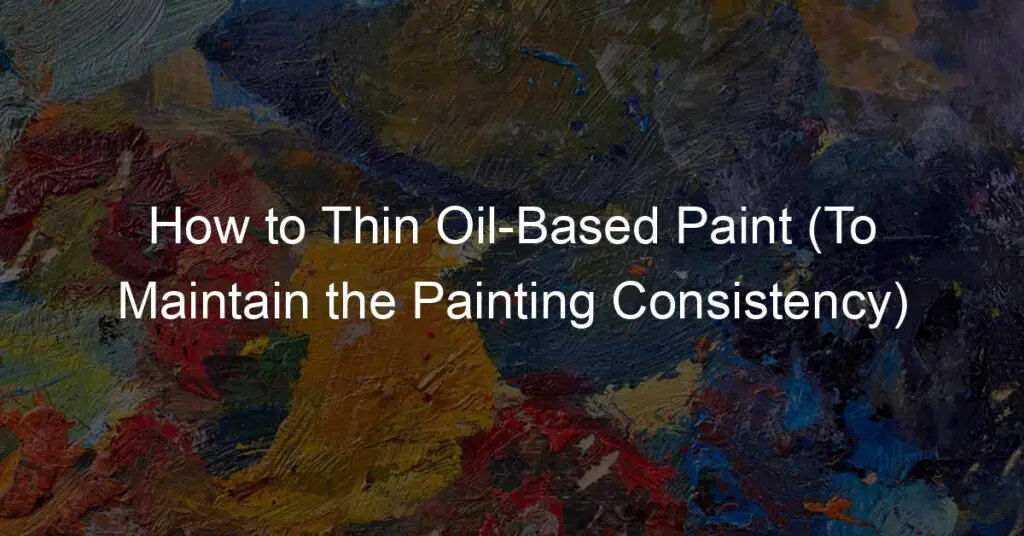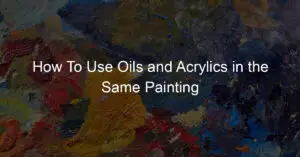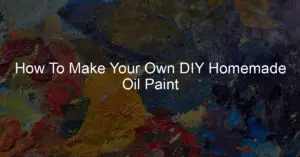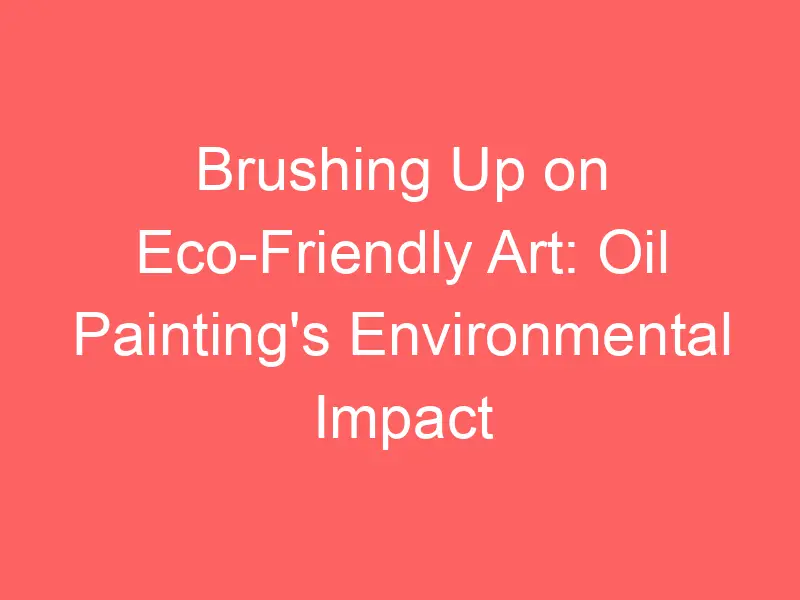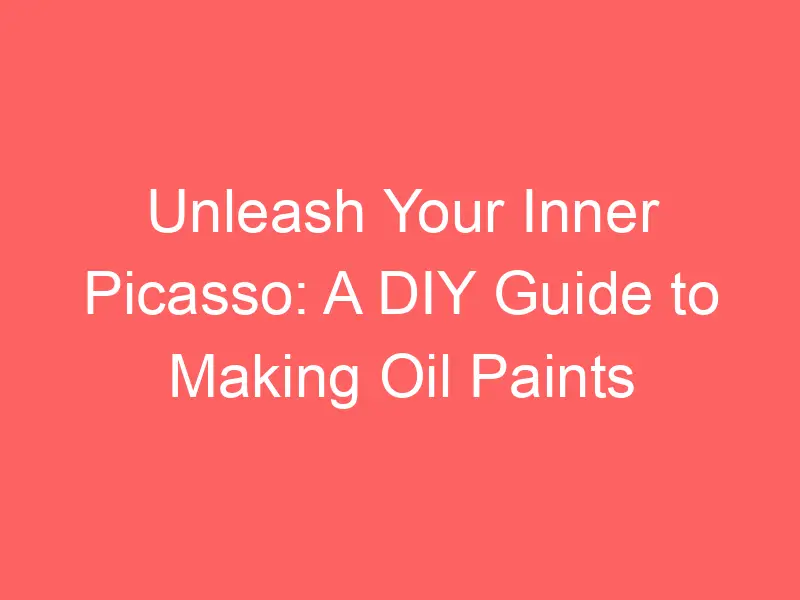Oil-based paint is known for its durability and rich finish, making it a popular choice for a variety of painting projects. However, oil-based paint can sometimes be thick and challenging to apply, especially in areas that require a smooth, even coat. Thinning the paint can help achieve the desired consistency and make it easier to work with, while also improving its drying time.
To properly thin oil-based paint, it is important to understand the specific type of paint being used and the appropriate thinning agent. This article will guide you through the process of thinning oil-based paint, ensuring optimal results for your painting project. With these tips in hand, you’ll be ready to tackle any oil-based painting task with ease and confidence.
Understanding Oil-Based Paints
Viscosity
Oil-based paints are known for their high viscosity, meaning they are thicker and more substantial than water-based alternatives like acrylics or latex paints. The oil content in these paints contribute to the increased viscosity, and as a result, oil-based paints require thinning before use to achieve the desired consistency and flow.
Drying Time
One notable characteristic of oil-based paints is their drying time. Due to their oil content, these paints can take longer to dry compared to other types of paint. In general, oil-based paints can take anywhere from 8 to 24 hours to fully dry, depending on various factors like temperature, humidity, and the specific paint formula.
Texture
The texture of oil-based paints is unique and highly valued by many artists and professionals. Due to the paint’s viscosity and longer drying time, it can be layered and blended more easily, creating rich textures and intricate finishes. The final result is a smooth and durable finish that is resistant to common household wear and tear, making it a popular choice for furniture, cabinetry, and other high-traffic areas.
Remember that working with oil-based paints requires patience and attention to detail in order to achieve the best results. By understanding their key properties – viscosity, drying time, and texture – you’ll be well-equipped to tackle any project involving this versatile paint type.

Why Thin Oil-Based Paint
Painting Technique
Thinning oil-based paint can significantly improve the painting technique you use. When oil paint is too thick, it can be challenging to achieve the desired texture and brushstrokes. By thinning the paint, you gain more control over its application, resulting in a smoother and more even finish. Thinning oil paint can also help adhere to the fat over lean rule, which recommends applying thinner layers of paint (lean) underneath thicker layers (fat) to prevent cracking and promote durability.
Improving Adhesion
Another essential benefit of thinning oil-based paint is enhanced adhesion. Without proper adhesion, paint layers can separate and cause the surface to become unstable. This poor adhesion is often caused by a phenomenon called sinking in, where the underlying layers of paint absorb some of the oil from the subsequent layers, leaving the paint to appear dry and uneven. Thinning oil-based paint can help combat sinking in and improve overall adhesion by allowing the paint to spread evenly and bond more effectively with the surface. This results in a more stable and long-lasting finish.
To summarize, thinning oil-based paint is vital for achieving a better painting technique, adhering to the fat over lean rule, preventing sinking in, and improving the paint’s overall adhesion to the surface.
Choosing the Right Thinning Agents
When thinning oil-based paint, it’s essential to select the appropriate thinning agents. There are a variety of ways to thin oil paint, and these options generally fall into three categories: natural oils, solvents, and resins.
Natural Oils
Natural oils can act as thinning agents for oil-based paint, as they are compatible with the paint’s composition. Common natural oils used in this process include:
- Linseed oil: Derived from flax seeds, linseed oil is a popular choice for oil painting due to its drying properties and compatibility with pigments.
- Walnut oil: A slower-drying alternative to linseed oil, walnut oil is less likely to yellow over time.
- Safflower oil: With similar drying characteristics to walnut oil, safflower oil is an option for artists looking to retain color vibrancy in their work.
Solvents
Oil-based paint can also be thinned using solvents which evaporate quickly, leaving only the pigment and binding medium behind. Some commonly used solvents are:
- Turpentine: Derived from pine tree resin, turpentine is a strong solvent and effective in thinning oil paint, but its strong odor may be an issue for some users.
- Mineral spirits: Also known as white spirit or paint thinner, mineral spirits are less harsh than turpentine but still effective at thinning oil paint.
- Citrus solvent: A natural alternative to petroleum-based solvents, citrus solvents are made from citrus peel oil and provide a pleasant odor while still effectively thinning oil paint.
When working with water-based paints, like latex paint, different thinning agents like water or alcohol may be used instead.
Resins
Resins can be added to oil paint to both thin the paint and improve its glossiness and durability. Some of the resins used for this purpose are:
- Pine tree resin: A source of natural turpentine, pine tree resin can also be added directly to oil paint for a more viscous mixture.
- Maroger medium: A combination of mastic resin, lead-tin solution and oil, maroger medium creates a pliable consistency that allows for smooth blending.
Remember, always mix thinning agents and oil paint in a well-ventilated area, and test the mixture on a small surface before applying it to your final work. Using these thinning agents confidently and knowledgeably will ensure that your oil paintings have the desired consistency and appearance.

Thinning Oil-Based Paints
Selecting the Correct Ratio
When thinning oil-based paints, it’s essential to maintain the proper balance between paint and thinning medium. A common rule of thumb is to start with a 1:1 ratio, meaning equal parts paint and medium. However, the ideal ratio might vary depending on the paint’s thickness and the desired level of fluidity. Here’s a simple guideline:
- Thinner paint: Start with a 1:1 ratio and adjust if needed
- Thicker paint: Use a 1:2 ratio, and modify as required
Remember that adding too much medium can affect the paint’s drying time and durability.
Mixing the Paint Properly
To mix the paint correctly, follow these steps:
- Prepare your space: Work in a well-ventilated area to avoid inhaling fumes. Wear gloves and a respirator for protection.
- Choose your tools: A paint stirrer or palette knife is ideal for mixing oil-based paint and thinning mediums.
- Mix in increments: Begin by adding a small amount of thinning medium to the paint, incorporating it thoroughly.
- Test the consistency: Use a brush to apply a small amount of the thinned paint on a sample surface. Adjust the ratio as needed to achieve the desired consistency.
- Repeat as necessary: Continue adding small increments of medium until you achieve the desired consistency for your oil painting project.
Following these guidelines will help you thin oil-based paint effectively while maintaining optimal performance and results.
Additional Considerations
Ventilation
When working with oil-based paints, it is important to ensure proper ventilation. The fumes from the paint and solvents like mineral spirits can cause headaches and may be harmful in confined spaces. To improve air circulation, consider setting up a box fan near your workspace or opening windows and doors.
Using an odorless solvent, like Gamsol by Gamblin, can help reduce the intensity of fumes. However, proper ventilation remains crucial even when using such products.
Safety Precautions
To minimize the risks associated with the toxicity of oil-based paint and solvents, follow these safety precautions:
- Wear gloves to protect your skin from direct contact with oils and solvents.
- Use a paint mask or respirator to reduce inhalation of fumes.
- Store paint and solvents in a well-ventilated area, away from heat sources or open flames.
Remember that while some products may claim reduced toxicity, it is still important to prioritize safety and adhere to the manufacturer’s guidelines.
Cleanup
Cleaning up after using oil-based paint requires some care. For an efficient and safe cleanup process, follow these steps:
- Make sure your workspace is well-ventilated to avoid inhaling fumes during cleanup.
- Use mineral spirits or another suitable solvent to clean brushes, rollers, and other tools.
- Dispose of used solvents, oils, and paint-soaked rags in a sealed, non-organic container to prevent spontaneous combustion.
It’s important to note that disposing of solvents and oil-soaked materials requires following local waste disposal regulations. Contact your local waste management authority for the specific guidelines in your area.

Alternative Thinning Options
Water-Resistant Compounds
Epoxide oil gel and neo-megilp are two water-resistant compounds that can be used to thin oil-based paint. They work by increasing the viscosity of the paint, which helps improve its flow and leveling properties. To use these compounds, mix them with your paint until the desired consistency is achieved.
Non-Toxic Options
For a more environmentally friendly and non-toxic approach to thinning oil-based paint, consider using drying oils like lavender, poppy, or poppy oil. These oils are derived from plant sources and work well as paint thinners. They can also enhance the durability and gloss of the paint. To add drying oils to your paint, simply mix them in until you reach the desired consistency.
Quick-Drying Solutions
Quick-drying solutions, such as galkyd and petroleum distillate, can be used to thin oil-based paint while speeding up the drying process. Galkyd, which is derived from pine trees, is a popular choice among artists. Petroleum distillate, on the other hand, is a versatile and affordable option that is easily available at most hardware stores. To use these quick-drying solutions, mix them with your paint until you achieve the desired thinning effect.
Finishing Your Painting
Varnishing
Varnishing your painting helps protect it and enhances the colors on the canvas. There are different types of varnishes, but the most common ones are matte, gloss, and satin. Choosing the right varnish depends on your preference and desired appearance.
Matte varnish provides a flat, non-reflective finish, which is ideal for minimizing glare on your painting. Gloss varnish, on the other hand, creates a shiny and reflective surface, which can make colors appear brighter and more vibrant. Satin varnish falls between matte and gloss, offering a subtle sheen that adds a soft glow to your painting.
When varnishing your painting, follow these steps:
- Make sure the paint is completely dry.
- Choose the type of varnish you want to use (matte, gloss, or satin).
- Apply the varnish in thin, even strokes, using a soft, wide brush.
- Allow the varnish to dry thoroughly before handling or displaying the painting.
Paint Finishes
Apart from varnishing, another way to enhance your painting is by using different paint finishes. Oil-based paints come in various finishes, such as matte, gloss, or satin, which can create unique effects on your painting.
When choosing a paint finish, consider the following factors:
- Matte finish is non-reflective and reduces glare. It works well for paintings with a lot of detail, as it doesn’t distract from the intricacies of the artwork.
- Gloss finish creates a shiny surface and can make colors look more vibrant. It is perfect for bold, abstract paintings, where the bright colors are the main attraction.
- Satin finish offers a balance between matte and gloss, with a subtle sheen that brings out the depth and texture in your painting. This finish works well with both detailed and abstract artworks.
Experiment with different paint finishes to find the one that best suits your style and desired appearance for your painting. Combine finishes to create depth and contrast within your artwork. By mastering the art of thinning oil-based paints and proper finishing techniques, you can create stunning, professional-quality paintings.
Frequently Asked Questions
What is the ideal ratio for thinning oil-based paint?
The ideal ratio for thinning oil-based paint depends on the specific paint and application. Generally, a range of 4:1 to 8:1 (paint to thinner) is suggested for most purposes. Always refer to the manufacturer’s recommendations for the appropriate ratio.
Can mineral spirits be used to thin oil-based paint?
Yes, mineral spirits are a common choice for thinning oil-based paint. They provide good solvency and evaporate slowly, reducing the risk of brush marks or uneven drying.
Is it possible to thin oil-based paint with water?
No, water cannot be used to thin oil-based paint. Water and oil do not mix, and adding water to oil-based paint may cause separation or poor adhesion. Use a compatible thinner, such as mineral spirits or turpentine, for thinning oil-based paint.
How to thin oil paint at home using household items?
For thinning oil paint at home, stick to traditional paint thinners like mineral spirits or turpentine. Avoid using non-recommended materials, as they may damage the paint or cause undesirable reactions.
Do I need to thin oil paint before use?
Thinning oil paint is not always necessary, but it can be helpful for specific applications. Thinning can improve the paint’s flow, making it easier to spread and work with. It may be required for spray painting or when using a fine brush to achieve smooth, even coverage.
Can alcohol be used to thin oil paint?
In general, alcohol is not recommended for thinning oil paint. Alcohol evaporates quickly, which can lead to a loss of binders and cause the paint to become too brittle. It is best to use a compatible thinner like mineral spirits or turpentine for thinning oil paint.

